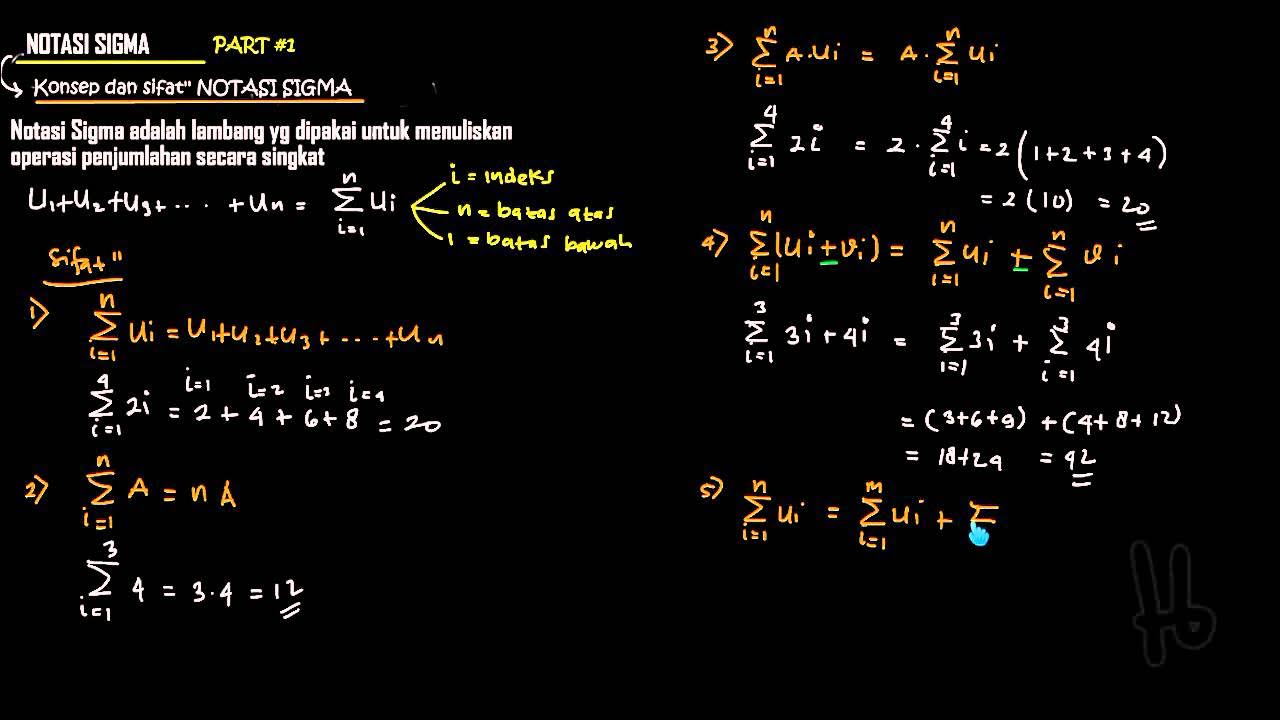NOTASI JUMLAH - MODUL 1 KB 2 STATISTIKA PENDIDIKAN PEMA 4210
Summary
TLDRIn this educational video, the instructor explains the concept of summation notation in statistics, breaking down several examples to illustrate the process. The video covers the calculation of sums using different variables, starting with basic examples and progressing to more complex scenarios involving two variables. The instructor provides step-by-step guidance on how to interpret and compute summation expressions, simplifying the process for students. This tutorial aims to enhance understanding of summation notation, making it accessible for students studying statistics.
Takeaways
- 😀 The lesson is focused on teaching statistical notation, specifically sigma notation and summation of series.
- 😀 The first example demonstrates how to calculate the sum of values X1, X2, X3, and X4, using sigma notation with the limits from 1 to 4.
- 😀 The sum is calculated by substituting the values of X1, X2, X3, and X4 into the sigma notation and adding them up.
- 😀 The second example involves two variables, X and Y, where the sum of a function involving both variables is calculated using sigma notation.
- 😀 In the second example, the sigma notation summation is performed for i = 1 to 3, and each term is simplified step-by-step.
- 😀 The example simplifies to finding the sum of terms like 4X1 - Y1 + 5, 4X2 - Y2 + 5, and 4X3 - Y3 + 5.
- 😀 Each term in the summation is carefully substituted with the given values of X and Y, such as X1 = 1, X2 = 3, X3 = -2, Y1 = 2, Y2 = 4, and Y3 = -1.
- 😀 After simplifying each term in the summation, the result is obtained by combining the terms and calculating the final sum.
- 😀 In the third example, sigma notation is applied to calculate the sum of squares of values X1, X2, and X3, each added with 1 and squared.
- 😀 The summation in the third example is carried out from i = 1 to 3, and the squares of X1, X2, and X3 are calculated and summed up, yielding the final result.
Q & A
What is the primary topic of the lecture in the transcript?
-The primary topic of the lecture is statistical notation, specifically the use of summation notation in mathematics and its application to solve problems.
What does the notation Sigma (Σ) represent in statistics?
-The Sigma notation (Σ) is used to represent the sum of a series of numbers. It indicates that we should add up a sequence of terms, often defined by an index, such as i = 1 to 4.
How does the lecturer describe the process of solving a summation problem?
-The lecturer explains the process by first identifying the variables and the range for the summation. Then, they substitute the values of the variables into the summation expression and perform the arithmetic operations step-by-step to find the sum.
In the first example, what are the values of X1, X2, X3, and X4?
-In the first example, the values of X1, X2, X3, and X4 are 2, 4, 6, and 8, respectively.
How do you compute the sum of the expression Sigma i=1 to 4 for the values of X?
-To compute the sum, you substitute the values of X1, X2, X3, and X4 into the summation expression: Σ(i=1 to 4) Xi. This results in 2 + 4 + 6 + 8, which equals 20.
In the second example, which variables are being summed?
-In the second example, both X and Y variables are being summed, specifically the expression involves terms with both X and Y values.
What values are given for X1, X2, X3, Y1, Y2, and Y3 in the second example?
-The values provided are X1 = 1, X2 = 3, X3 = -2, Y1 = 5, Y2 = 4, and Y3 = -1.
What is the final result of the second summation example?
-The final result of the second summation example is -6, after performing the calculations step-by-step.
In the third example, what is the task the students are asked to perform with the summation notation?
-In the third example, students are asked to compute the summation Σ(i=1 to 3) of the expression (Xi^2 + 1^2), where the values of X1, X2, and X3 are given.
How does the lecturer explain how to handle the expression (Xi^2 + 1^2) for the given values of X?
-The lecturer explains that for each value of X (X1, X2, and X3), you substitute it into the expression (Xi^2 + 1^2), square Xi, add 1 squared, and then perform the summation for the values 1 through 3.
Outlines

This section is available to paid users only. Please upgrade to access this part.
Upgrade NowMindmap

This section is available to paid users only. Please upgrade to access this part.
Upgrade NowKeywords

This section is available to paid users only. Please upgrade to access this part.
Upgrade NowHighlights

This section is available to paid users only. Please upgrade to access this part.
Upgrade NowTranscripts

This section is available to paid users only. Please upgrade to access this part.
Upgrade NowBrowse More Related Video

SUMMATION NOTATION || GRADE 10 MATHEMATICS Q1

Barisan Deret ( Notasi Sigma )

01. Notación sigma (Sumatorias) ¿qué es? ¿cómo se usa?

Menuliskan Bilangan ke Dalam Bentuk Notasi Ilmiah yang Baku | Matematika SMP

Sumatoria - Notación Sigma | Aplicando propiedades Ejemplo 1

Transitividade Verbal [Prof Noslen]
5.0 / 5 (0 votes)